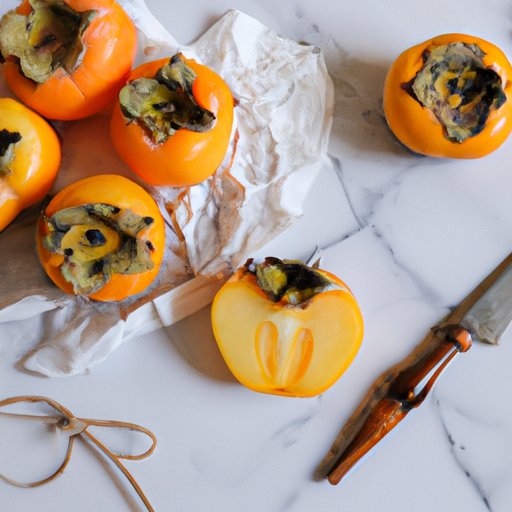
Introduction
Have you ever seen a persimmon at the grocery store or farmer’s market and wondered what to do with it? These bright orange fruits can be intimidating for some people to eat, but with a little know-how, they can become a delicious and versatile addition to your diet. In this article, we will cover everything you need to know about persimmons, including how to choose and eat them, recipe ideas, storage tips, and health benefits.
A Beginner’s Guide to Eating Persimmons
Persimmons come in two main varieties: astringent and non-astringent. Astringent persimmons, such as the Hachiya variety, are very tart and bitter until they are fully ripe. Non-astringent persimmons, such as the Fuyu variety, can be eaten when they are still slightly firm and have a sweet, crisp flavor. When choosing persimmons, look for ones that are plump, shiny, and free of blemishes.
To eat a persimmon, start by washing it thoroughly and cutting off the top stem. If you have a ripe Fuyu persimmon, you can eat it like an apple, slicing it into wedges or biting into it whole. For a Hachiya persimmon, which is much softer and more delicate, you’ll want to slice it in half and scoop out the flesh with a spoon. The flesh should be soft, almost custard-like, and have a mild, sweet flavor.
If you want to get creative with your persimmon consumption, try using them in salads, on cheese boards, or even grilled or roasted for a sophisticated side dish.
5 Delicious Recipes for Persimmon Lovers
Persimmons can be used in a variety of sweet and savory dishes. Here are five recipe ideas to get you started:
- Persimmon and Goat Cheese Salad: Toss sliced persimmons and crumbled goat cheese with arugula and a lemon vinaigrette for a light and flavorful salad.
- Spiced Persimmon Muffins: Incorporate persimmon puree into your favorite muffin recipe, adding warm spices like cinnamon and nutmeg for extra flavor.
- Grilled Persimmon Skewers: Thread chunks of persimmon onto skewers with other veggies like bell peppers and onions, then grill until charred and caramelized.
- Persimmon and Brie Crostini: Top slices of baguette with brie cheese and roasted persimmon slices for a decadent appetizer.
- Persimmon Pudding: Blend persimmon puree with coconut milk, vanilla, and sweetener of your choice for a creamy and satisfying dessert.
Persimmons 101: Understanding the Different Types and How to Choose the Best Ones
In addition to the Hachiya and Fuyu varieties, there are also several other types of persimmons, including the cinnamon-flavored Chocolate persimmon and the Korean persimmon, which is often used in Asian cuisine. When choosing persimmons, keep in mind that astringent varieties should be completely soft and ripe, while non-astringent varieties can be enjoyed when they are slightly firm.
To get the most flavor out of your persimmons, try roasting or grilling them, or adding them to smoothies or homemade jam. You can also use them as a natural sweetener in recipes, substituting persimmon puree for other sugars or syrups.
Using Persimmons in Your Baking
If you have a surplus of ripe persimmons, consider using them to bake with. Persimmon puree can be substituted for up to half of the total amount of fat and sugar in a recipe, adding moisture and sweetness without any added oils or processed sugars.
Try making persimmon bread, muffins, or cake, or adding persimmon puree to pancakes or waffle batter for a unique twist on breakfast classics.
How to Store Your Persimmons to Keep Them Fresh for Longer
To keep your persimmons fresh for as long as possible, store them in a cool, dry place, away from direct sunlight. If you have ripe persimmons that you’re not ready to eat yet, you can store them in the fridge for up to two weeks.
If you have more persimmons than you can eat in that time, you can also freeze them for later use. Simply puree the persimmons and freeze the puree in an airtight container for up to three months.
Persimmons and Health
Persimmons are a rich source of vitamins A and C, fiber, and antioxidants. They have been linked to improved heart health, digestive function, and even reduced inflammation. Adding persimmons to your diet can help boost your immune system and support your overall health and wellbeing.
Try incorporating persimmons into your smoothies, oatmeal, or yogurt bowls for a nutrient-packed breakfast, or add them to your afternoon snack for a sweet and satisfying treat.
Conclusion
Persimmons may seem intimidating at first, but they are a truly delicious and versatile fruit that can be used in a variety of dishes. Whether you prefer them sweet or savory, raw or cooked, there are countless ways to enjoy persimmons and reap their many health benefits.





